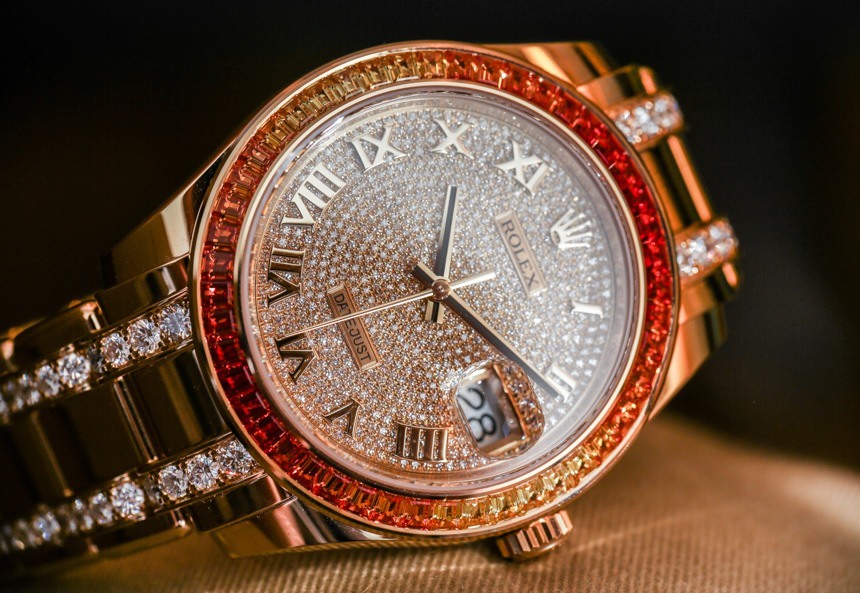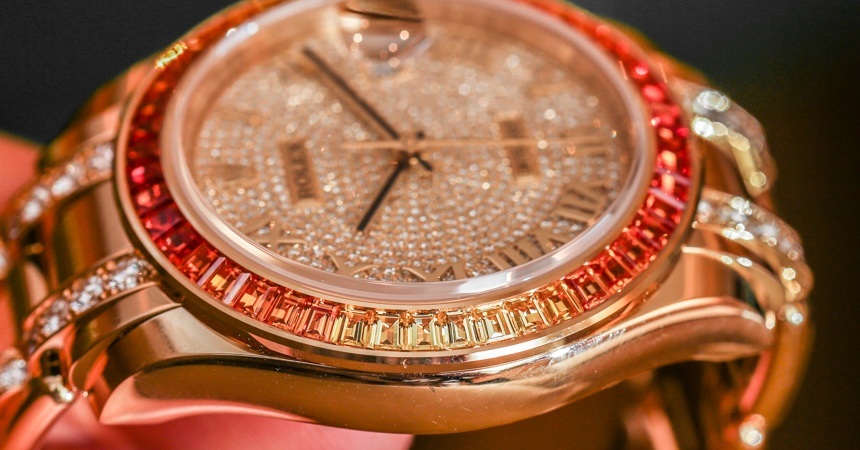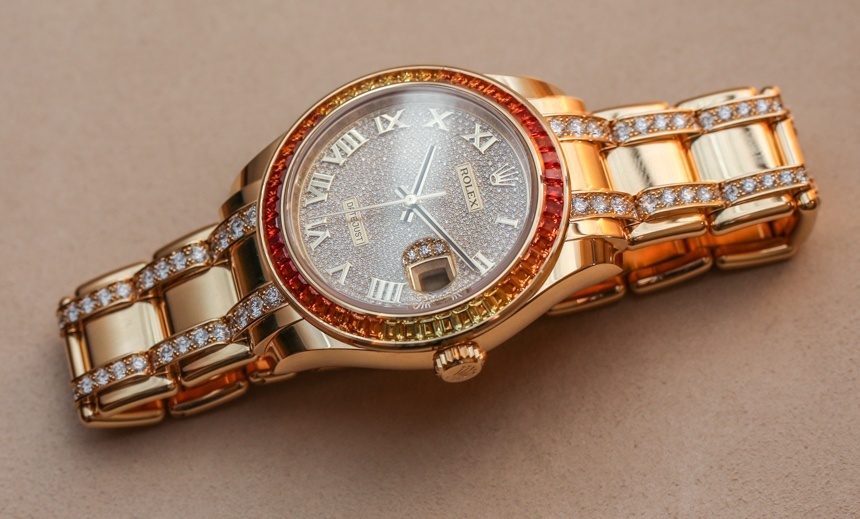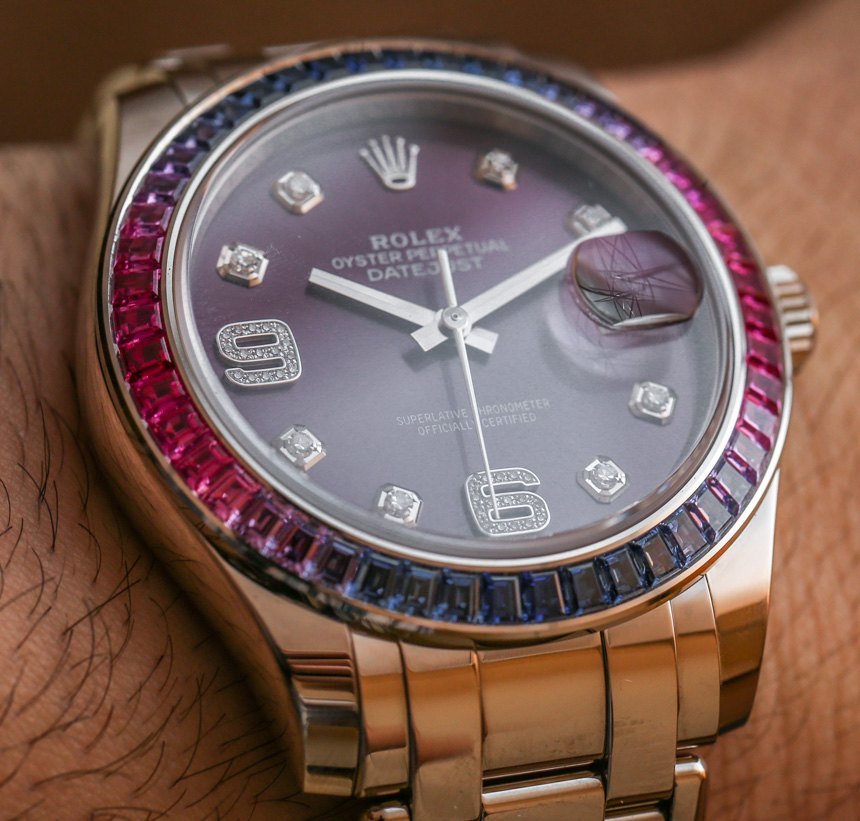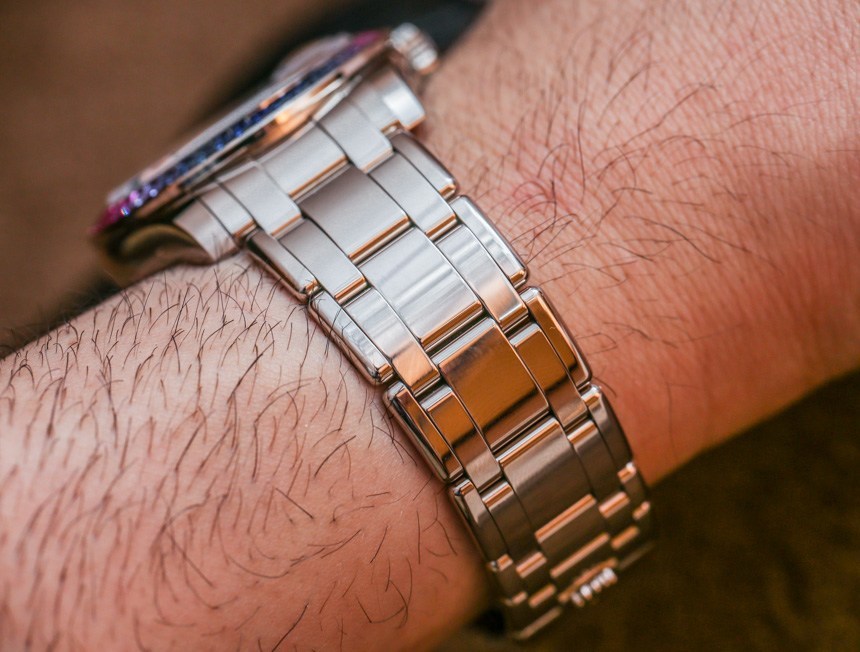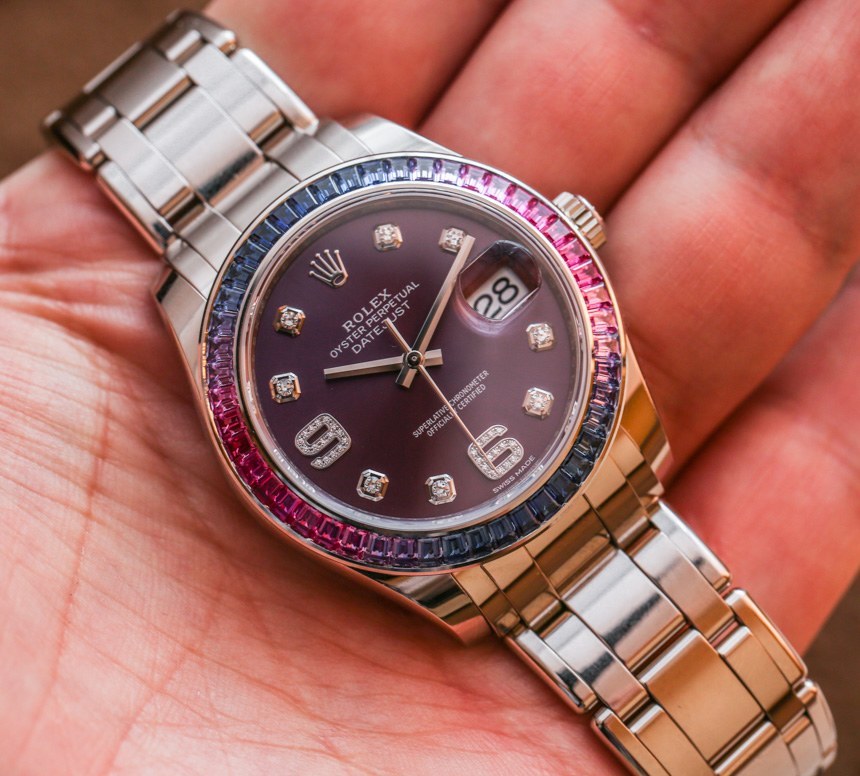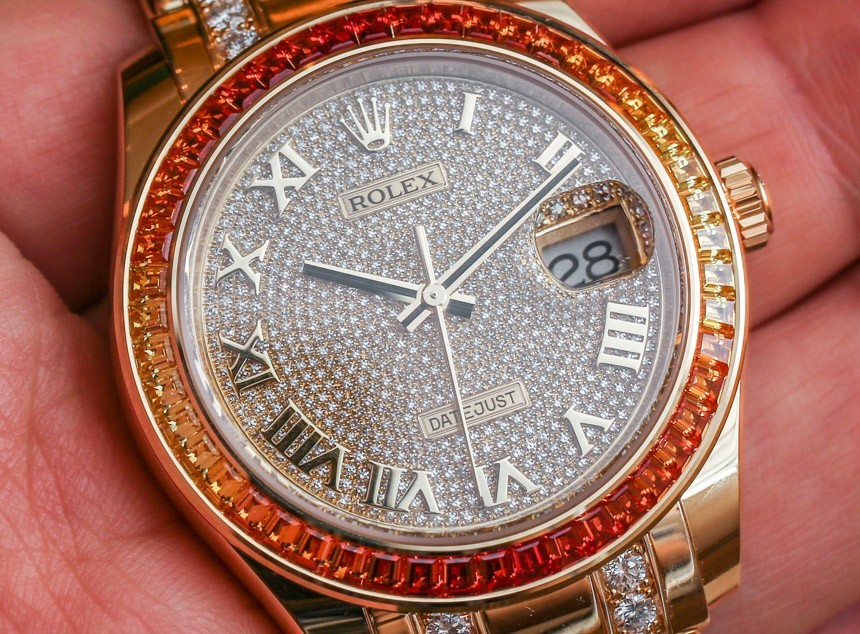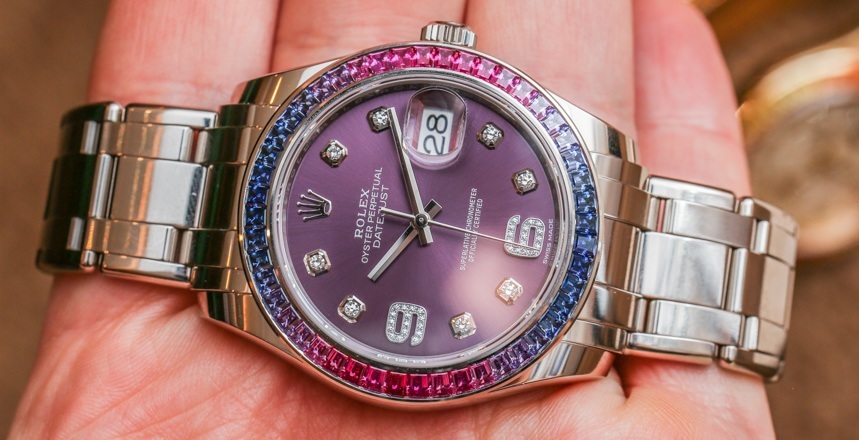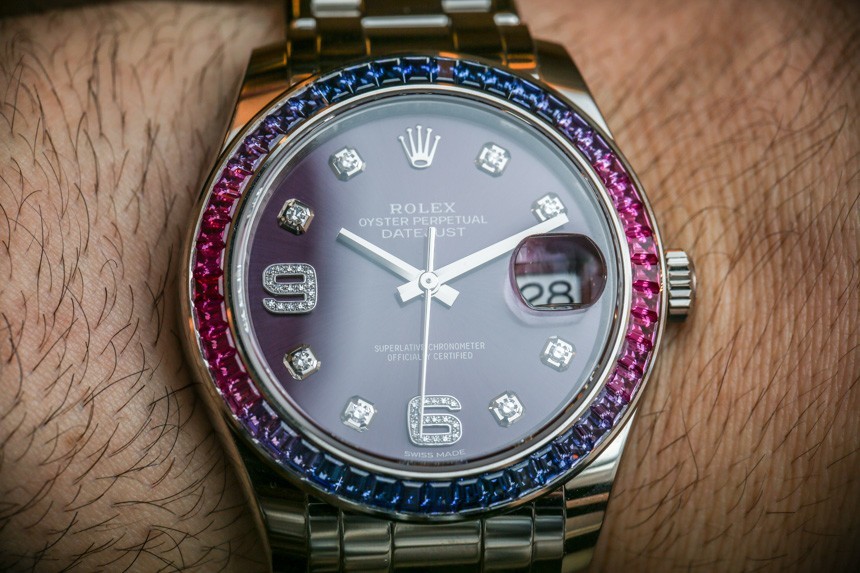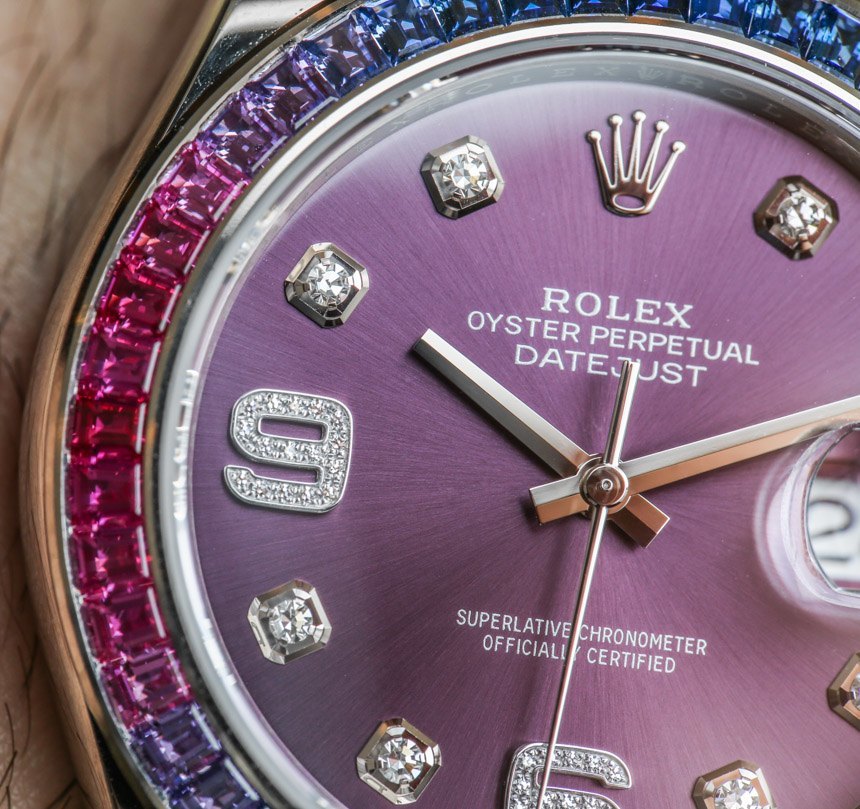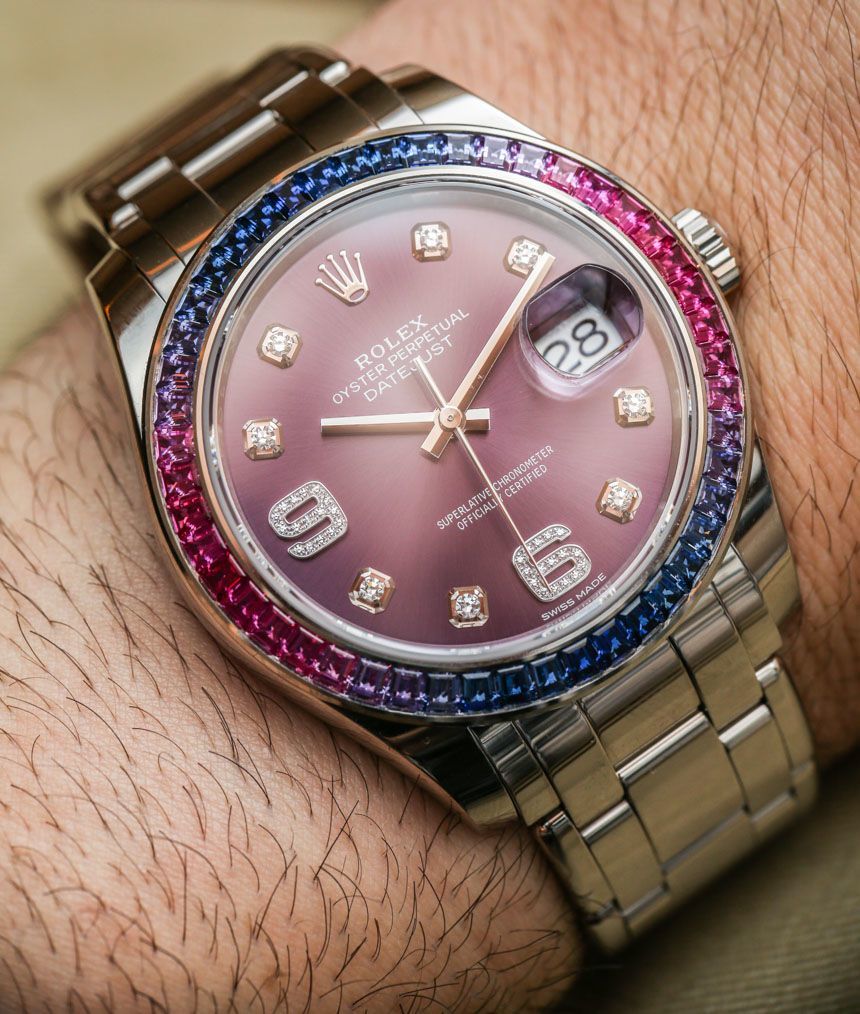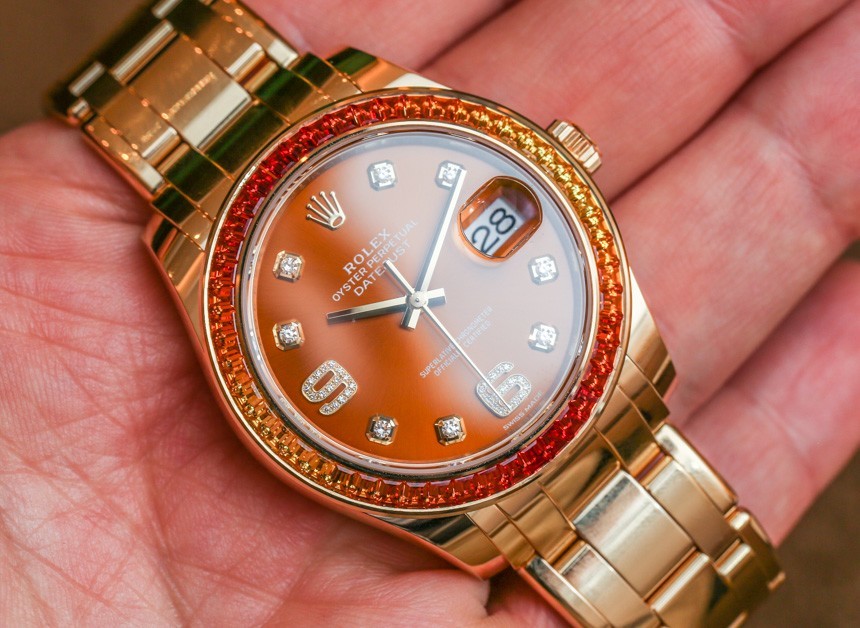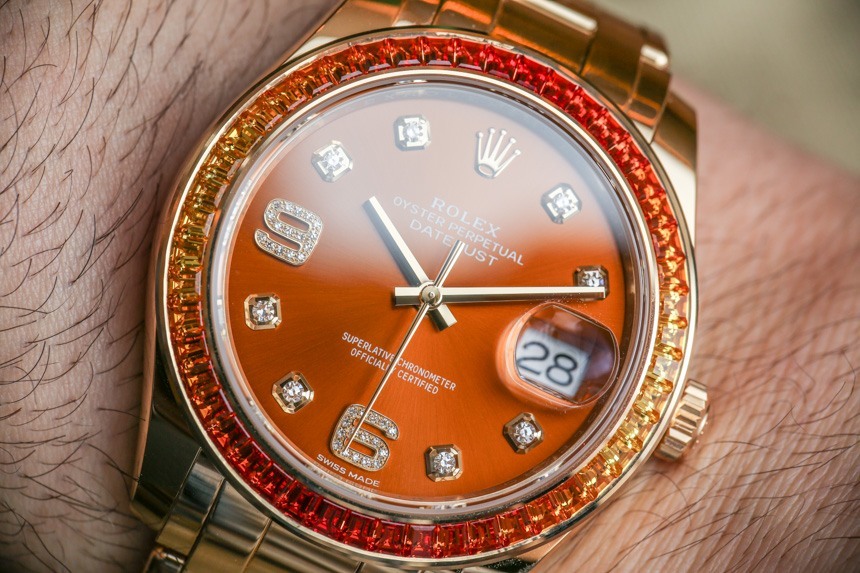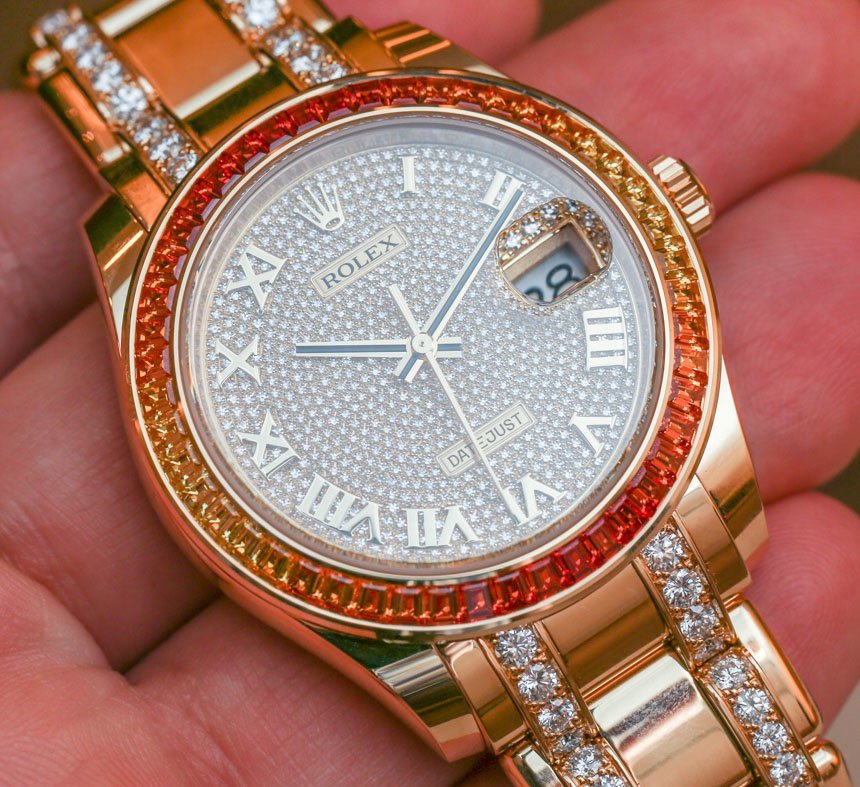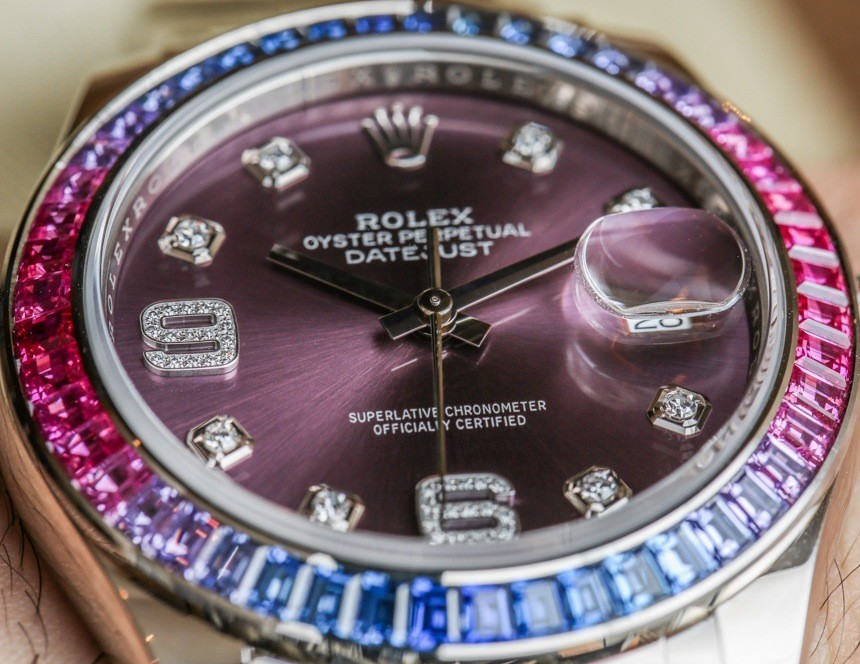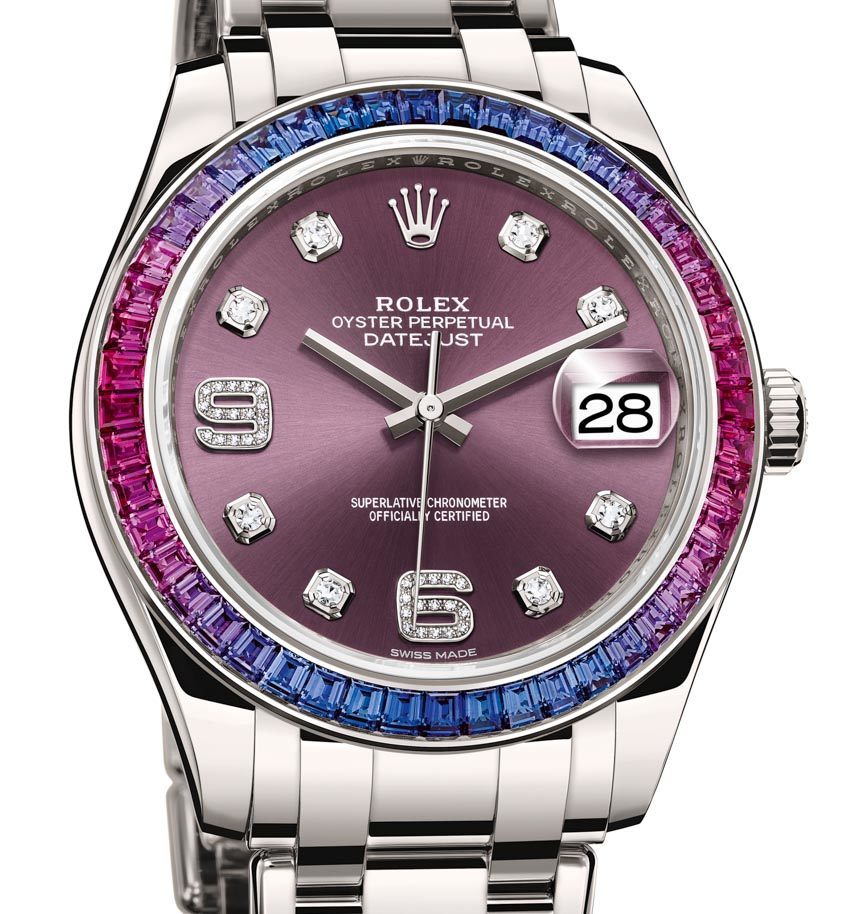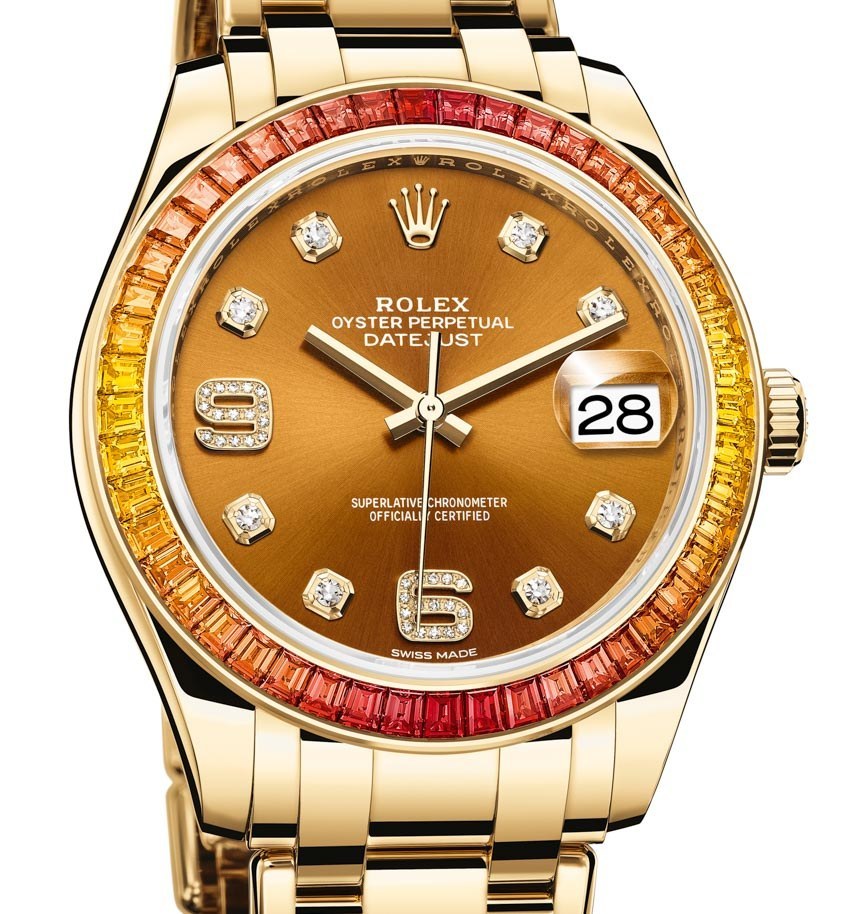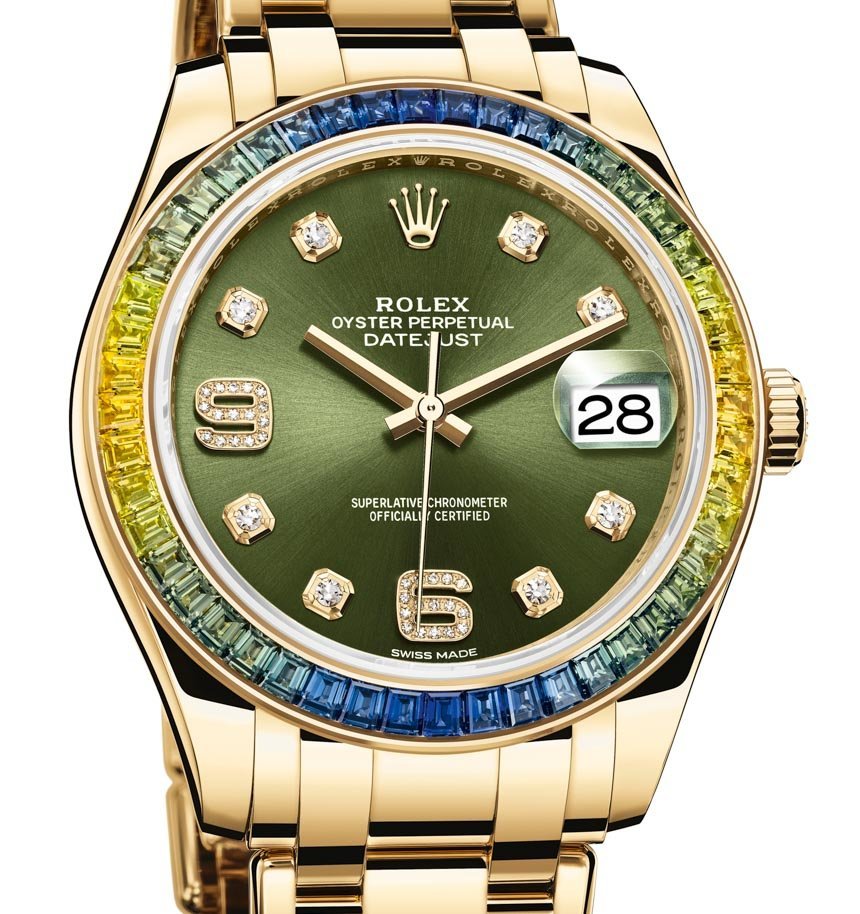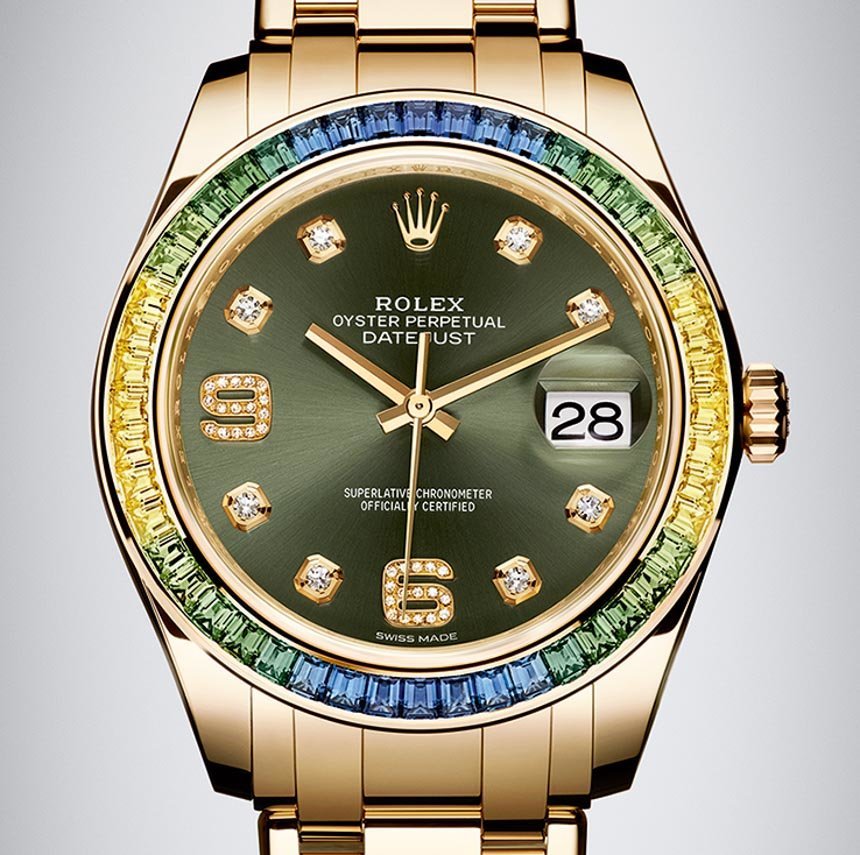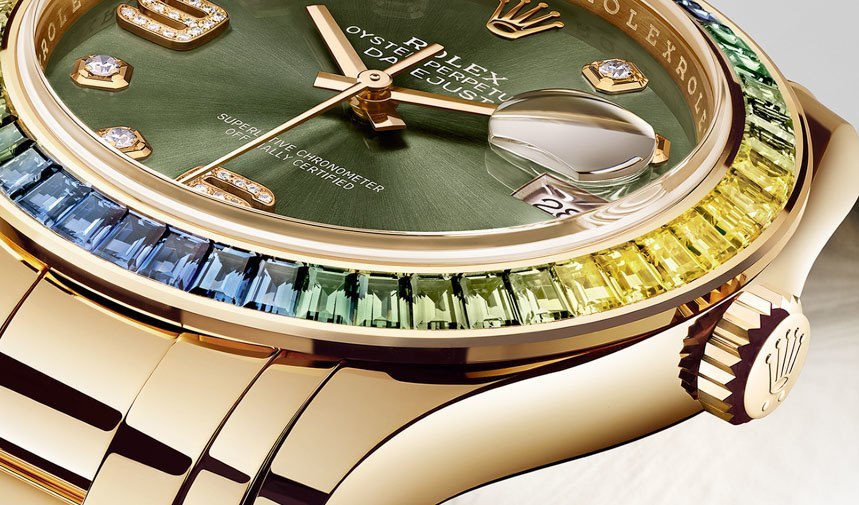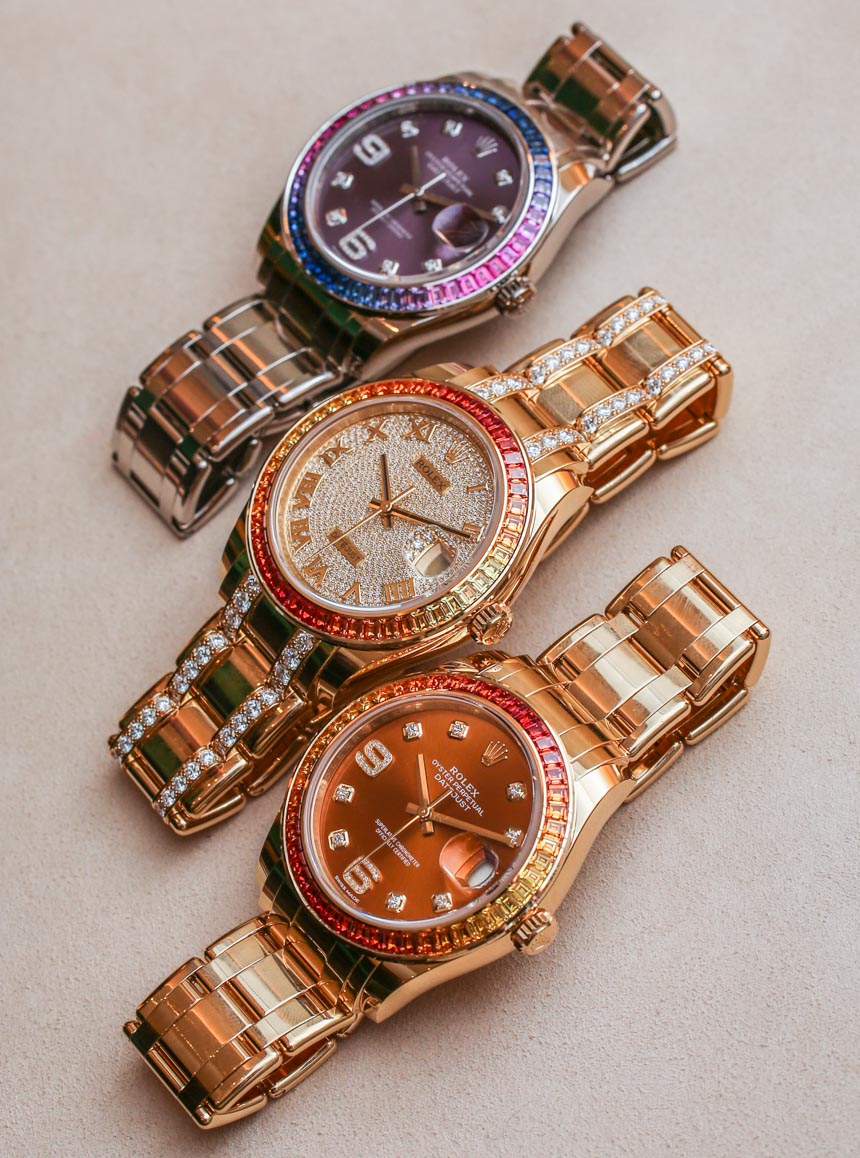
For 2015, Rolex added a new member to the Pearlmaster watch family with the Rolex Datejust Pearlmaster 39 – debuted here in a range of interesting stone-decorated varieties. This is exactly the type of watch that allows Rolex to both earn its merit among certain audiences and, at the same time, annoy fans of the brand mostly interested in their more classic sport watches.
While the Rolex Pearlmaster is generally considered a lady’s watch (often referred to as the “Lady-Datejust Pearlmaster” in smaller case sizes), this new 39mm-wide model does have a distinct feminine touch, but is also something that I know for a fact will appeal to male customers in various parts of the world. For that reason, I feel more than comfortable putting on what is essentially a woman’s watch that is, for at least some clients, good enough for a man. Of course, this is an interesting phenomenon, as most lady’s watches are actually smaller versions of men’s watches, and the reverse is quite uncommon.
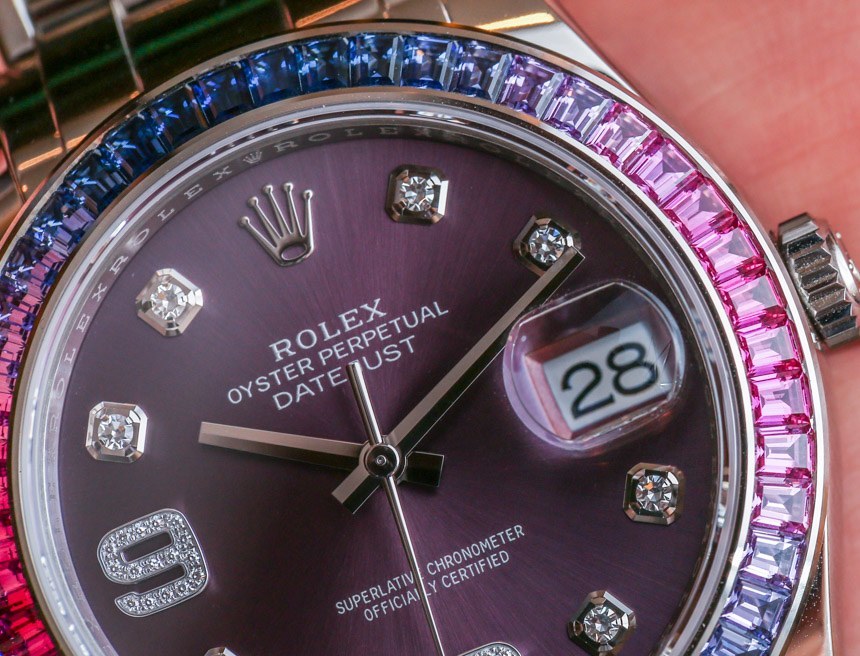
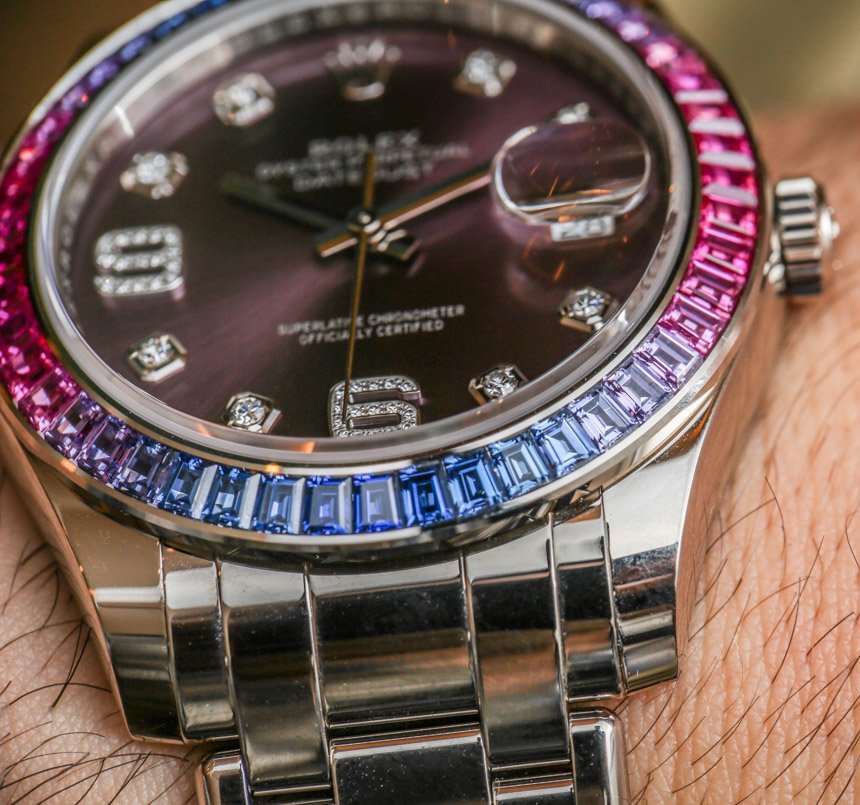
As far as I know, every Rolex Datejust Pearlmaster watch has some type of precious stone decoration (at least, that I have seen). The collection seems to have begun as a more “formal” or decorative version of the Rolex Lady-Datejust. The Rolex Datejust Pearlmaster watch collection begins with a petite 29mm-wide version, which goes up to 34mm wide, and now, 39mm wide. Each of them shares a special type of bracelet which is decidedly more “jewelry-like” than most other Rolex bracelets. Rolex simply calls this five-link bracelet the “Pearlmaster,” and it has a very smooth and pleasant feel when moving the links as well as wearing it.
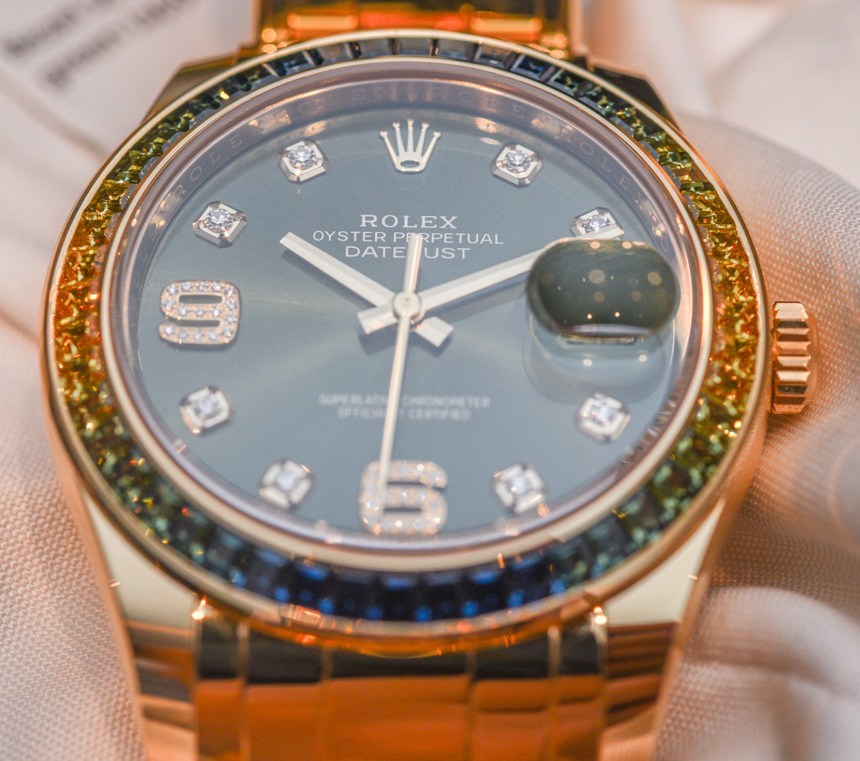
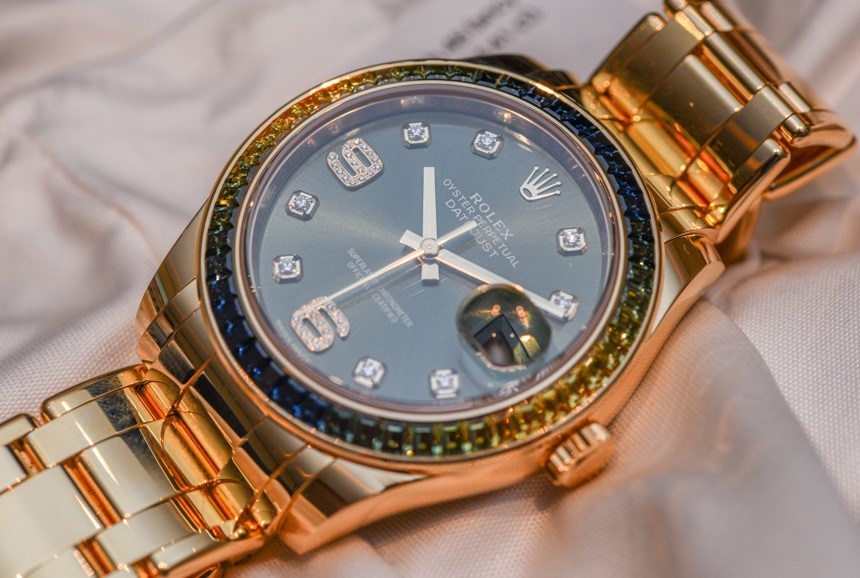
The 2015 Rolex Oyster Perpetual Datejust Pearlmaster 39 watch collection has a lot of similarities to another new-for-2015 Rolex release. Both the Rolex Datejust Pearlmaster 39 as well as the new Rolex Day-Date 40 watches (hands-on here) share the fact that they are the first watches to include ceramic inserts in the gold bracelets (more on that in a moment), as well as the 3235 family of movements. The Rolex Day-Date 40 watches contain the Rolex 3255 automatic movement rather than the 3235, but the only major difference, as far as I know, is the addition of the day of the week indicator disc in the 3255, whereas the 3235 has the time and date.
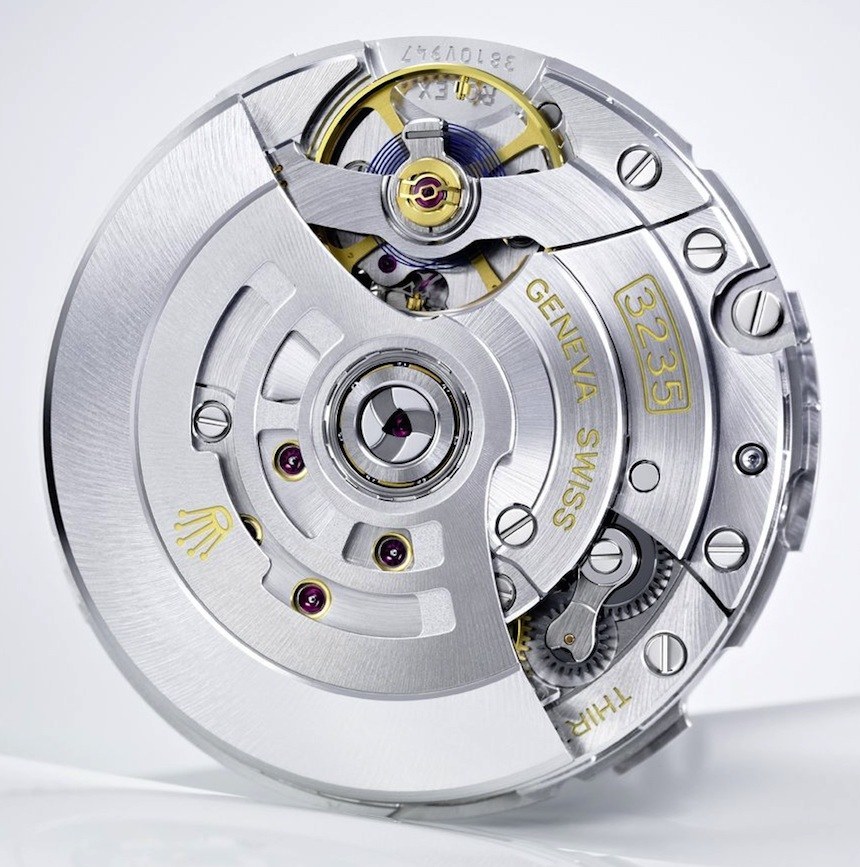
So, let’s discuss the movement for a moment. I actually recommend anyone keenly interested in the movement to read our above discussion on the 2015 Rolex Day-Date 40 watches. I referred to those watches as perhaps the finest timepieces that Rolex has produced to date. What makes the 3235 movement special is how dedicated it is to accuracy. In addition to the standard COSC Chronometer rating given to each individual movement, Rolex now employs their own barrage of tests to ensure accuracy and reliability over time – that they simply call the “Rolex Chronometer Tests.”
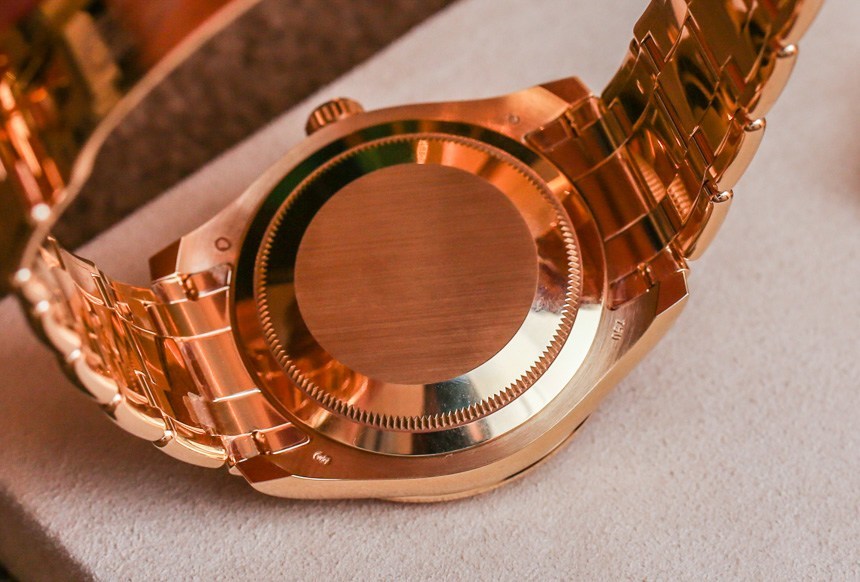
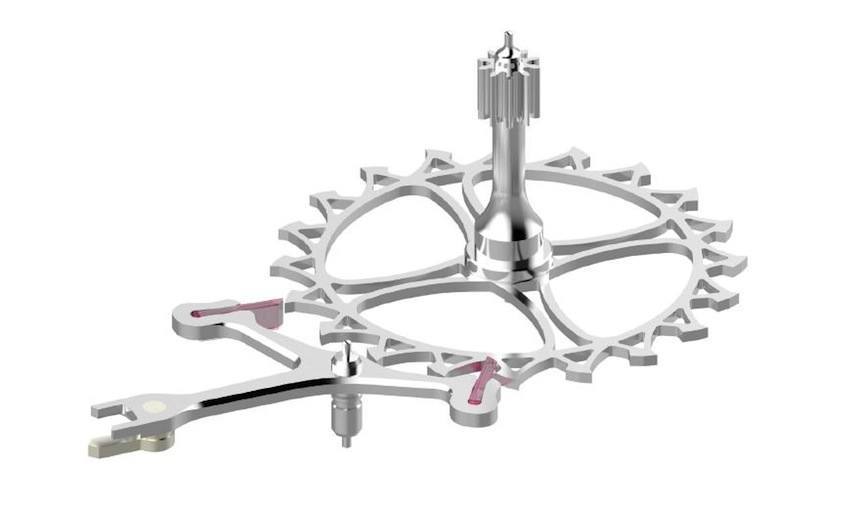
Inside the 3255 and 3235 automatic movements are the new Rolex Chronergy escapements along with variable inertia balance wheels. There is also a fancy Paraflex shock absorbing system to ensure more accuracy over time. While the 3235 movement isn’t about adding functionality, it is about further refining the longevity and performance of a Rolex movement. The 3235 further has a 4Hz (28,800 bph) operating frequency and a nice power reserve of about 70 hours. Rolex has mentioned that this new family of in-house made movements offers the most consistent high level of accuracy performance out of all the movements they have produced thus far. I fully expect that over time (though it will be slow), some of these new movement technology developments will find their way migrating to the movements used in more Rolex watch collections.
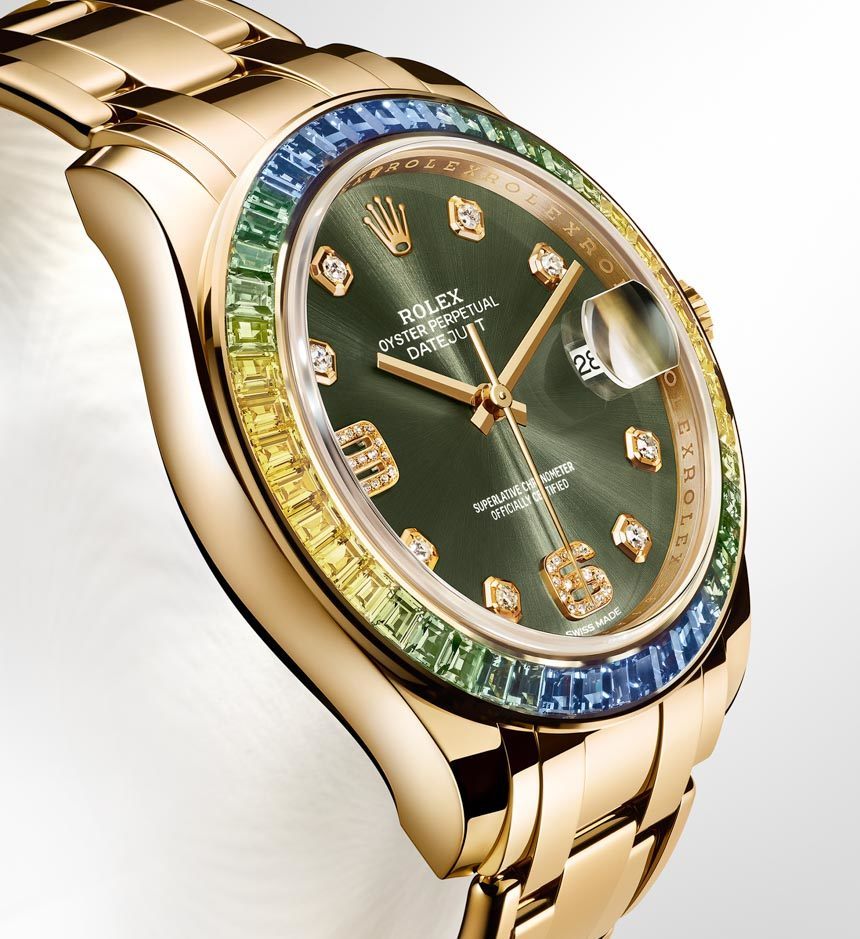
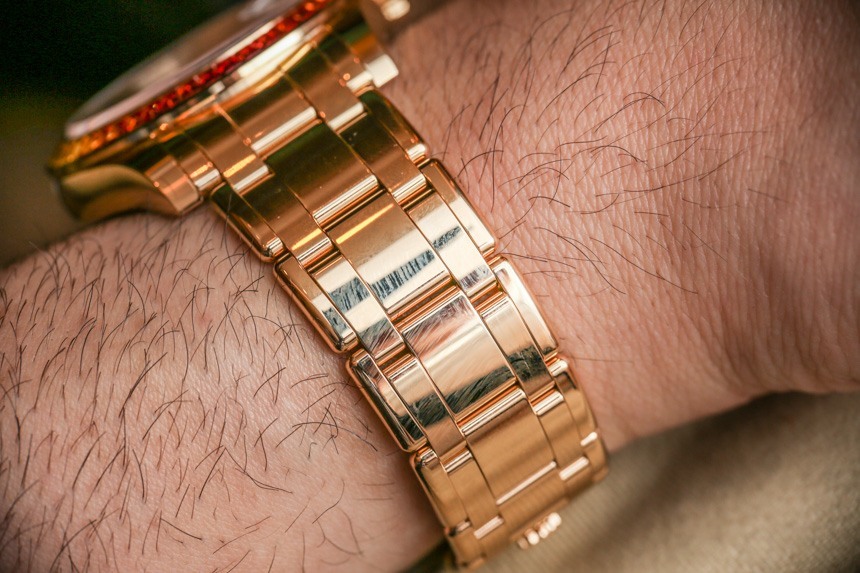
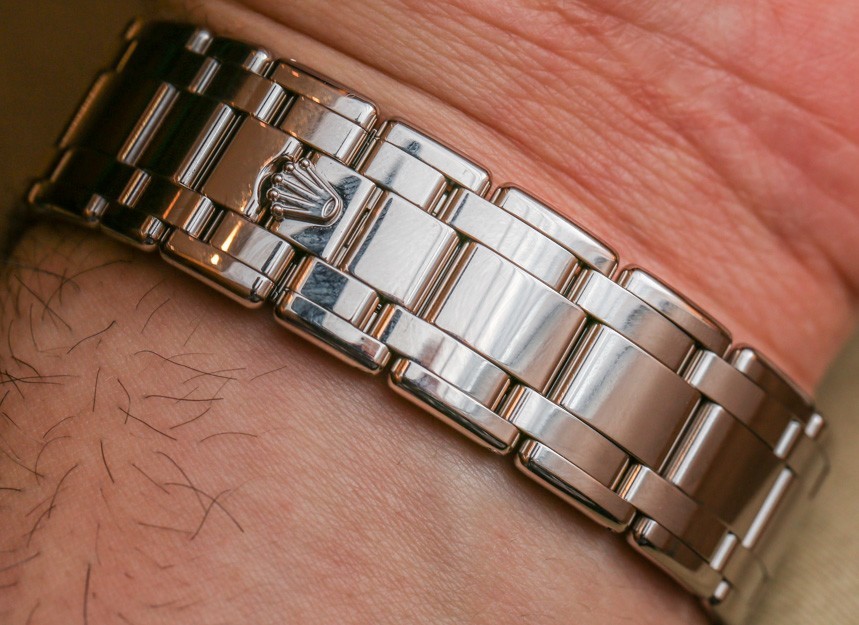
Above, I mentioned the ceramic inserts in the Rolex Pearlmaster bracelets. Let me explain that these inserts aren’t something you can see, but are rather hidden within the construction of the bracelet. The purpose of the ceramic inserts is to prevent any gold “stretching” that can sometimes occur over long periods of time where due to the softness of the metal, the links slowly deform. The ceramic inserts also protect the links from wearing over time as they fold over one another.
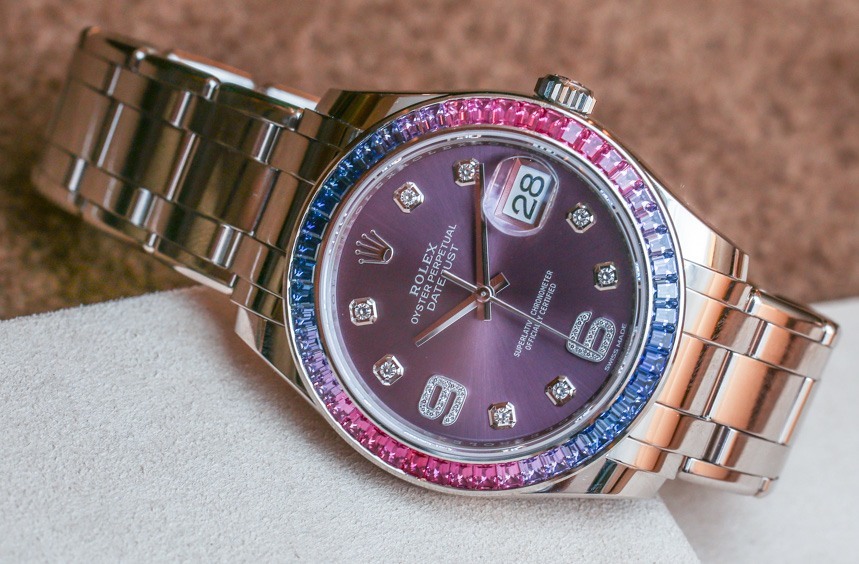
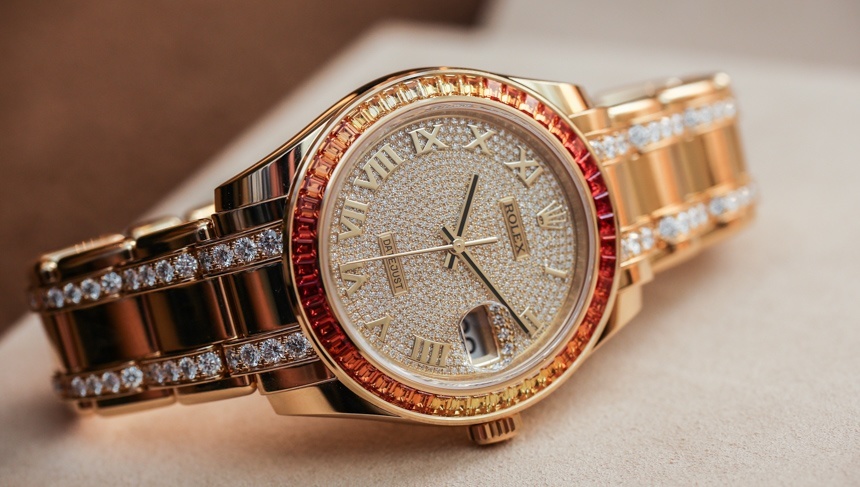
Having visited Rolex and seeing their production as well as product testing, this new feature feels like a very logical outcome of their routine durability tests. Rolex is perhaps the only watch brand I am familiar with who I’ve seen stress test their watches by artificially mimicking years of wear. Robots wear watches and move around to simulate long periods of wear. Rolex then carefully studies the results of these tests to see where weakness exists and to determine how best to improve their products. I suspect that the inclusion of the ceramic inserts into the links is a direct result of such testing and policies at the company.
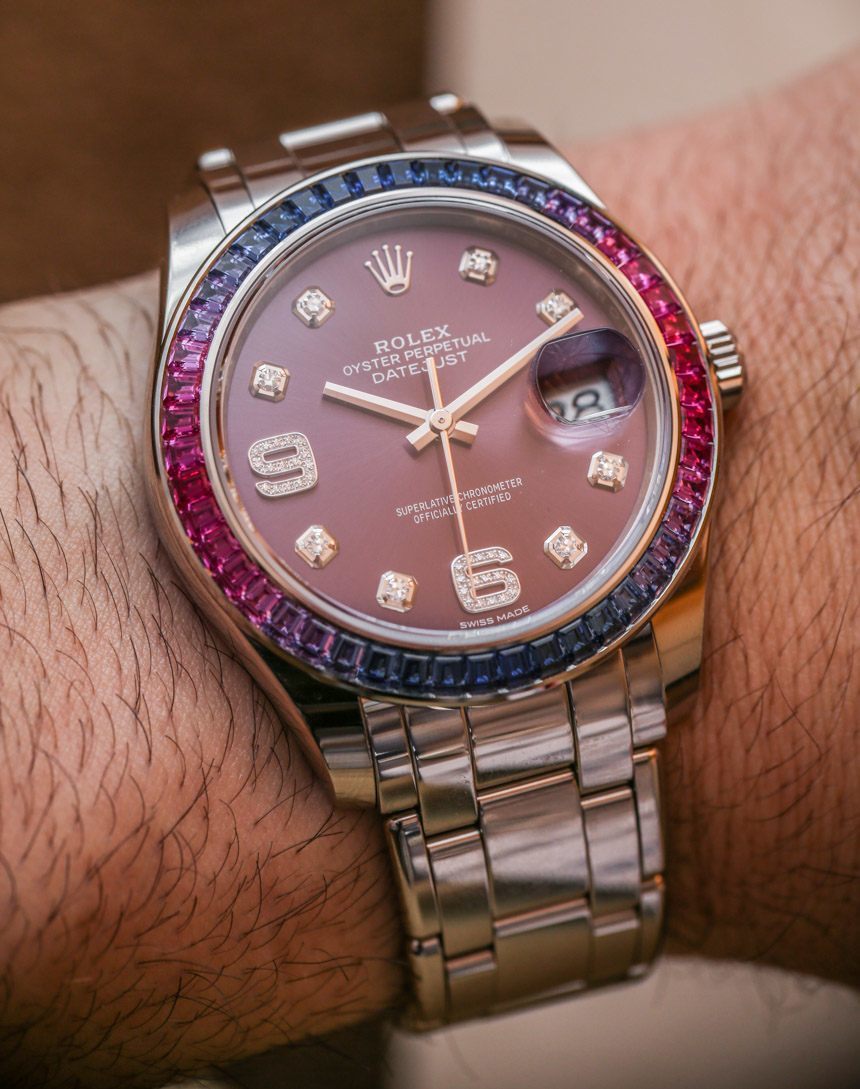
At 39mm wide, the new larger Rolex Datejust Pearlmaster 39 case loses the “Lady” designation and now feels like something that men would feel comfortable wearing. There are going to be plenty of people on this post complaining that no man should be seen wearing this timepiece, and I won’t argue with them, as that is a matter of taste. These would not be my first choice of stone-decorated Rolex watch, but the bold colors and beautiful detailing simply got me curious about wearing them.
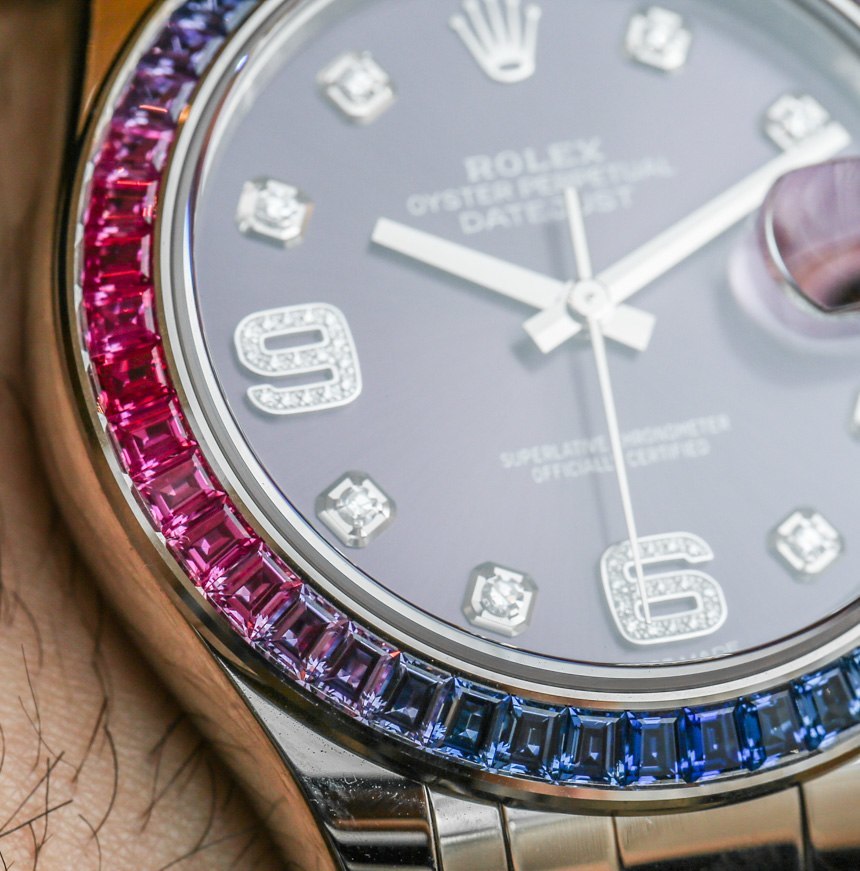
Those models which have stone-decorated bezels with color gradients are uniquely fascinating to behold and require considerable gemological effort in-house at Rolex’s gem-setting department. Finding and arranging the right colors and sizes of stones requires a huge amount of effort. People recall the “rainbow Daytona” with its colorful bezel, but few know that each rainbow-colored, precious-stone bezel requires about two weeks to produce.
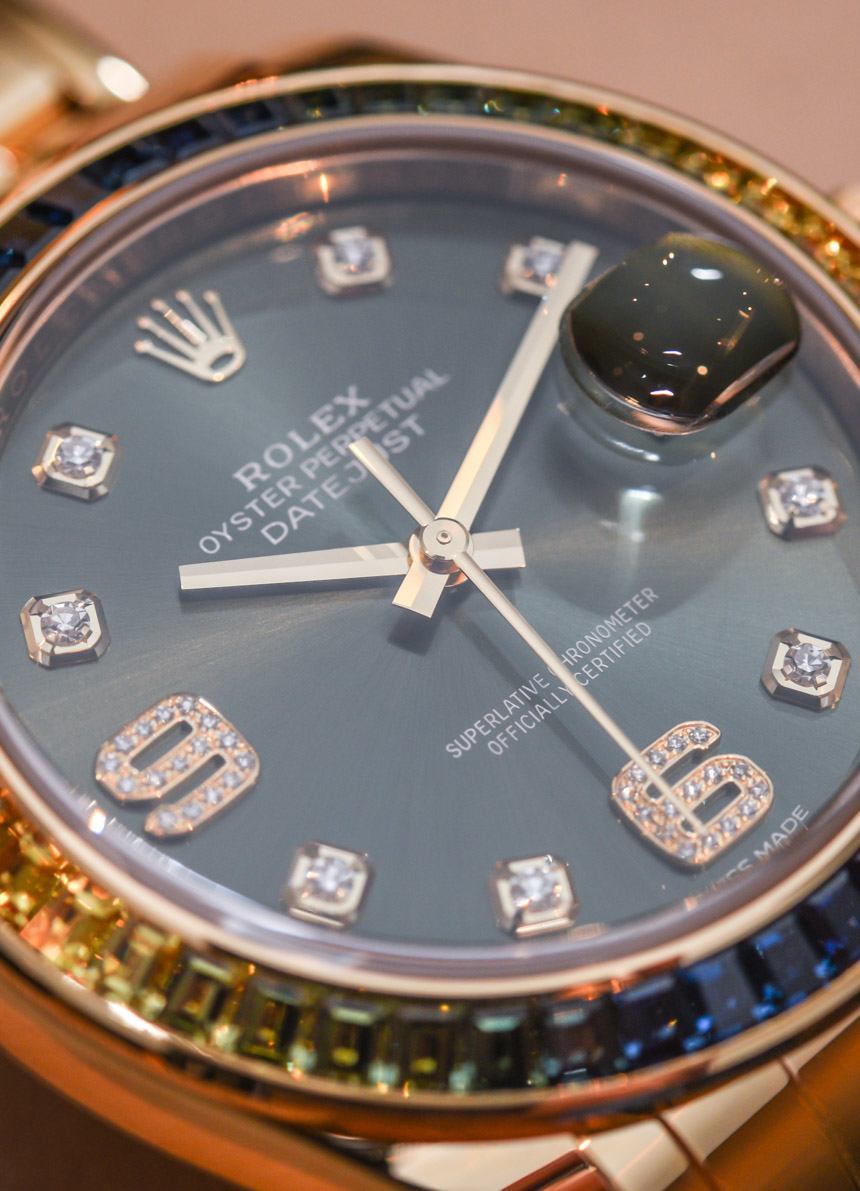
Each of these watches, save for the Rolex Datejust Pearlmaster 39 with the full pave dial, have bezels with 48 baguette cut sapphire stones of various colors. Each stone is, of course, hand-set. That same rule applies to each of the stones on the dial, including the diamond hour markers as well as the diamond-set Arabic numeral hour markers. I find it interesting that despite the Pearlmaster nature of the collection, the dials merely read “Oyster Perpetual Datejust” on them. The dials feature colors such as “olive green,” “cognac,” and “red grape” which match the stone colors on the bezel. Again, the colors themselves might not appeal to everyone (not that they are trying to), but what everyone should appreciate is the technique and the excellent use of stones and colors by Rolex.
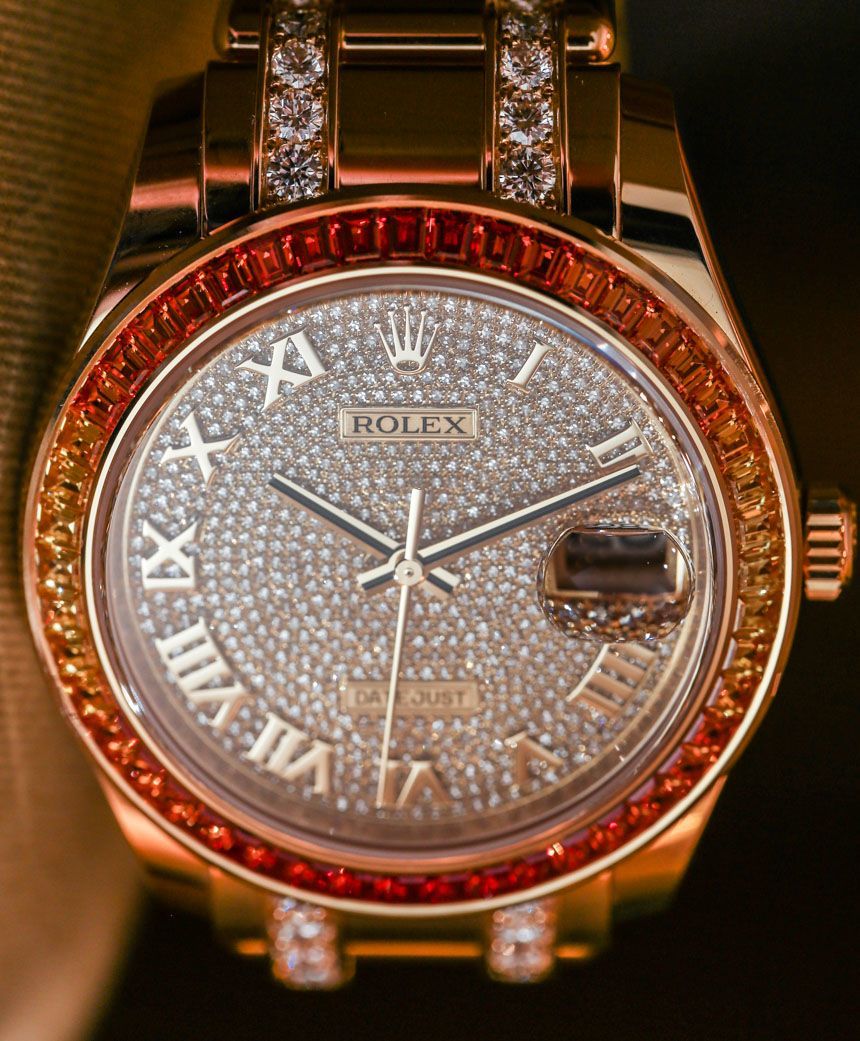
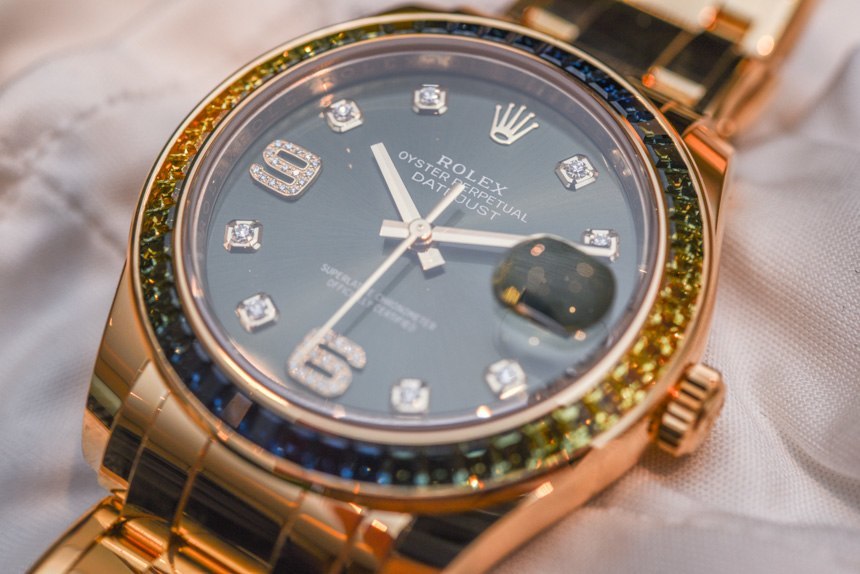
Interestingly enough, for 2015, there are a few 18k yellow gold versions of the Rolex Datejust Pearlmaster 39 as well as an 18k white gold model, but nothing in 18k Everose gold. I suppose Rolex is waiting to offer an Everose gold version – if it decides to do so at all. It is important to note that gem-set watches such as this represent the more high-end world of Rolex watches, as these timepieces are several times more expensive than most Rolex timepieces that are sold. A lot of the value comes from the complexity of setting the watches with a range of stone colors that nevertheless must live together in harmony.
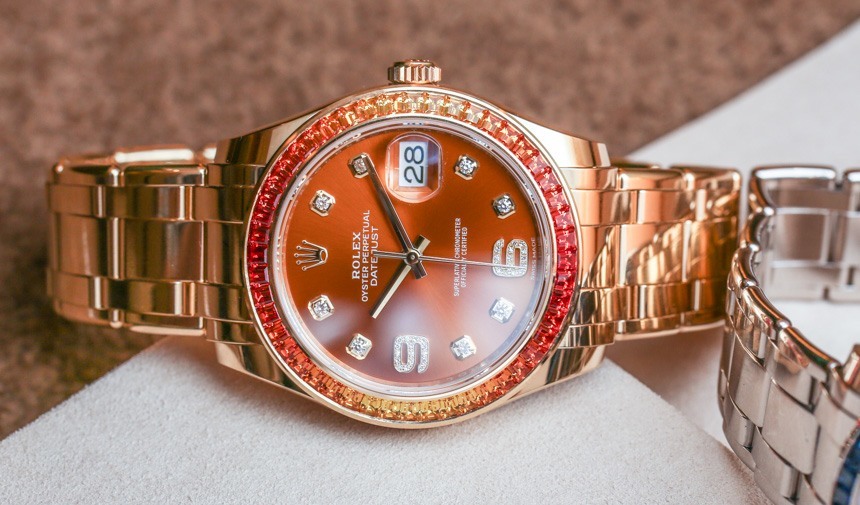
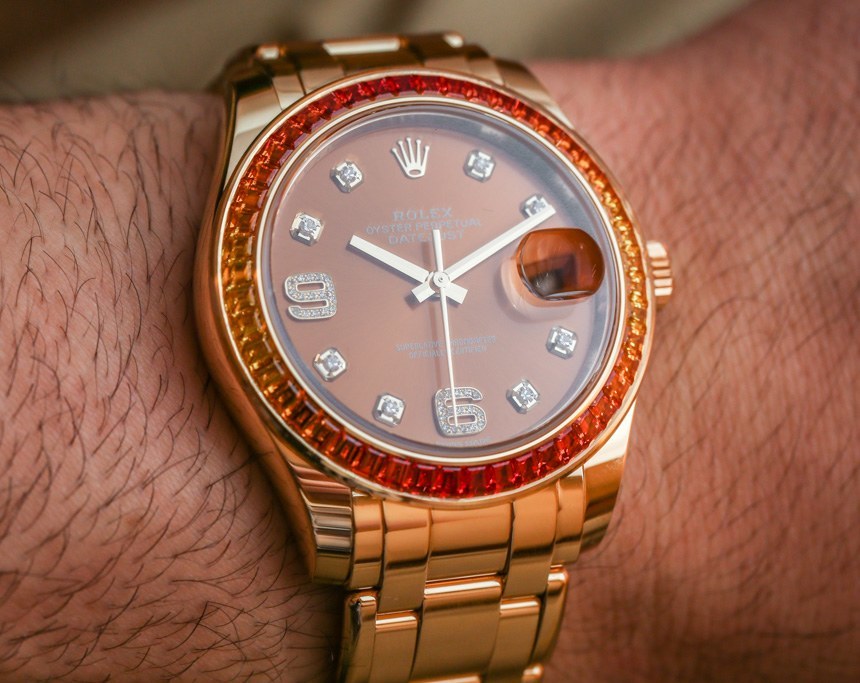
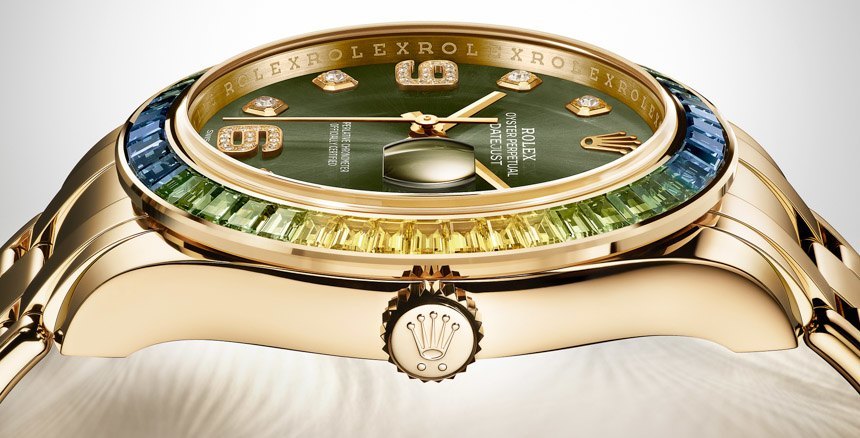
Rolex intentionally played with color, doing things such as having a blue to yellow/green gradient or purple to blue. These are exercises in color and gem-setting that just happen to mark the debut of the new 39mm-wide version of the Rolex Datejust Pearlmaster. While in the West, these would no doubt represent timepieces for women, there will be male buyers in the East, for sure.
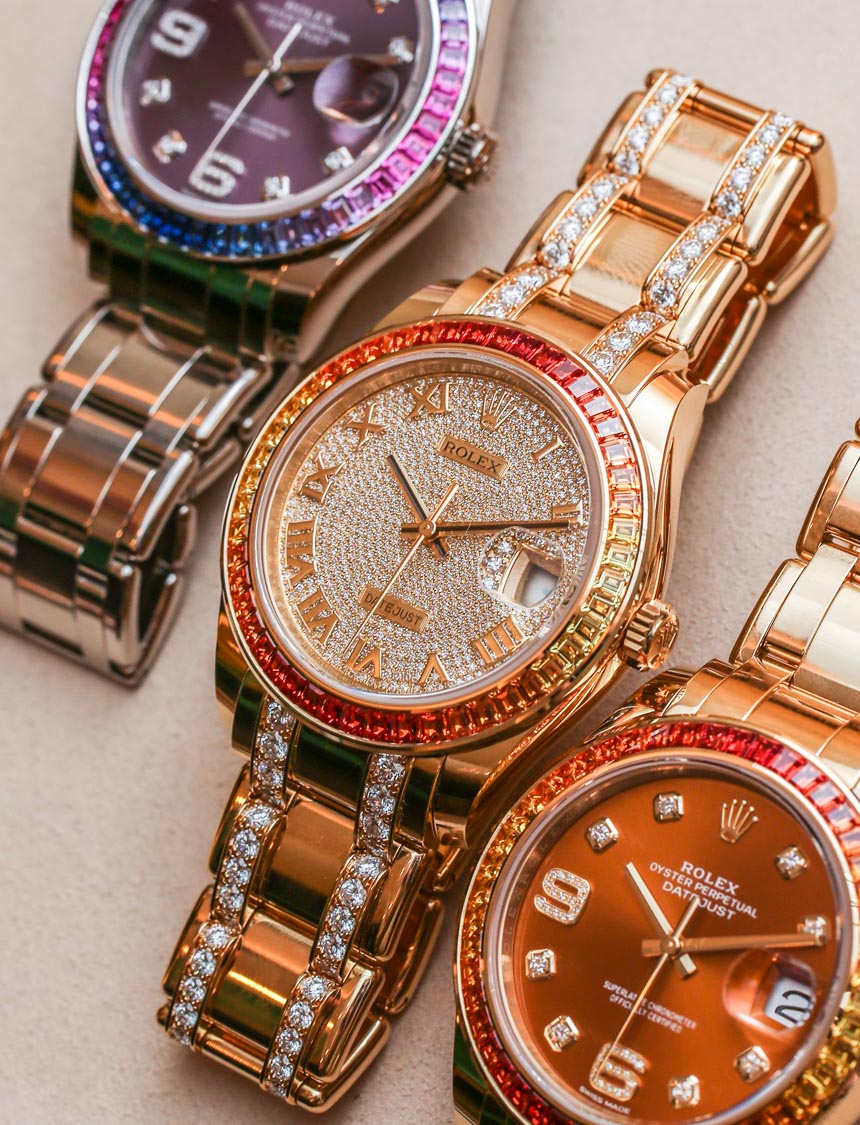
Rolex has been on an interesting kick lately, debuting new movement technology in very high-end watches – often with precious stones. For example, last year in 2014, Rolex debuted their silicon Syloxi balance wheels in the new women’s Datejust collection (decorated with a lot of precious stones). Here, again, you see the debut of the 3235 automatic movement that will likely inhabit more mainstream Rolex Datejust watches in the future, but presented in the glamorously niche Rolex Oyster Perpetual Datejust Pearlmaster 39 watch collection.
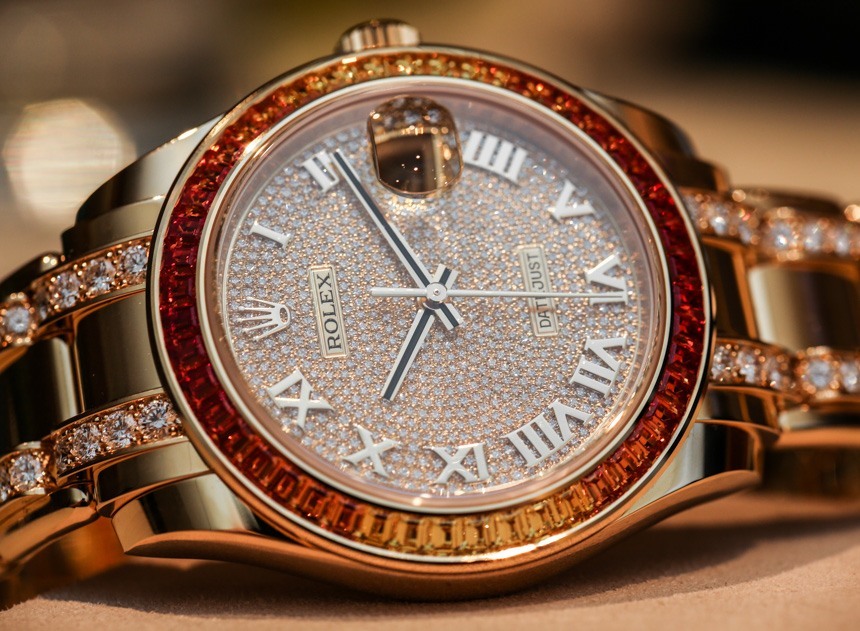
Prices are as follows: reference 86348 SAJOR 42748 (18k yellow gold with olive green dial) and 86348 SABLV 42748 (18k yellow gold with cognac dial) at 71,200 CHF, reference 86349 SAFUBL 42794 (18k white gold with red grade dial) at 83,200 CHF, and the 18k yellow gold with full pave diamomd-set dial reference 86348 SAJOR 44748 at 128,000 CHF. rolex.com

